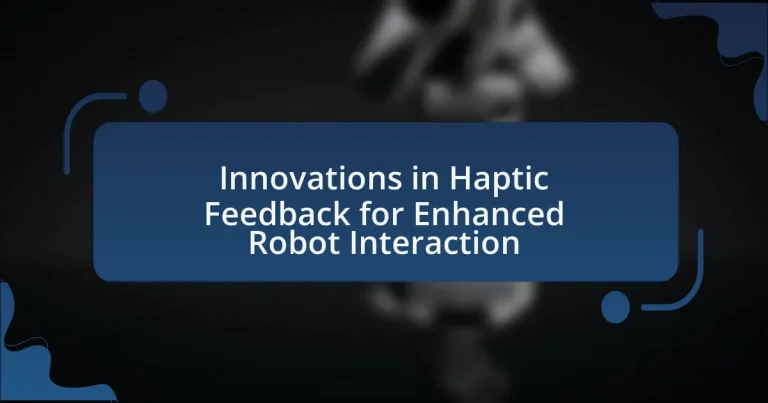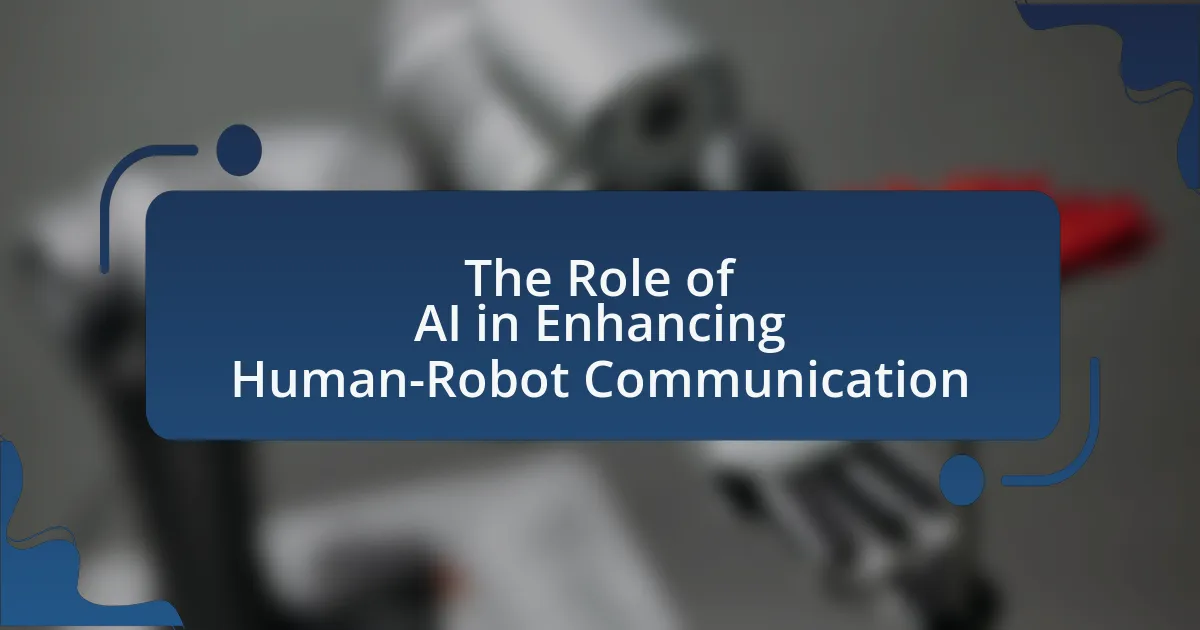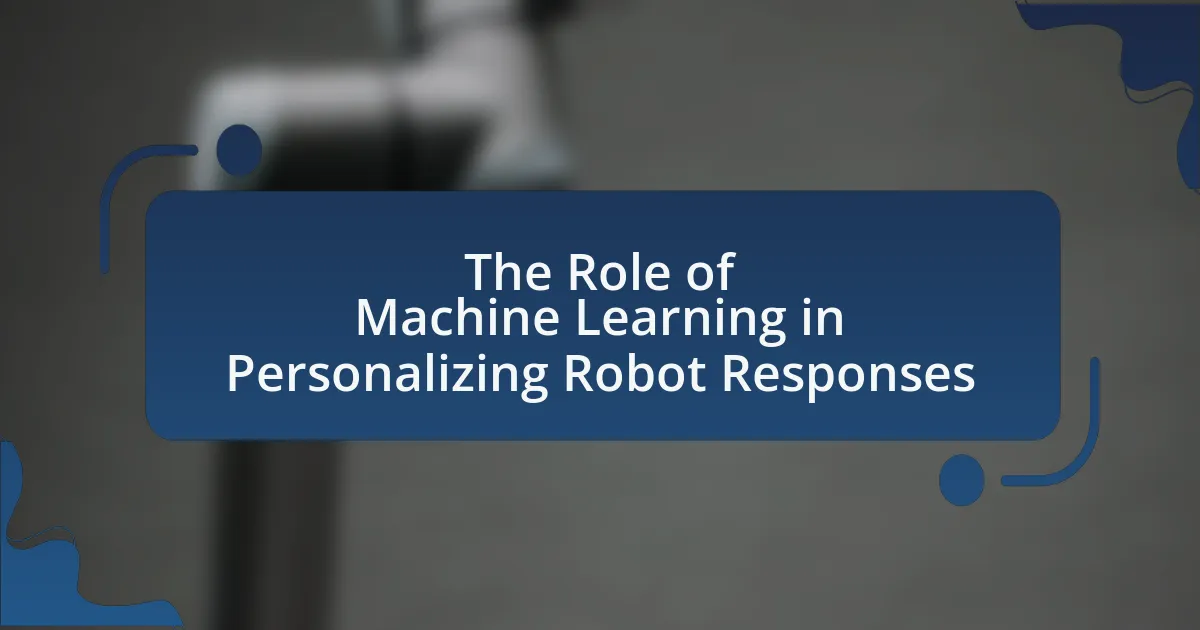Innovations in haptic feedback for enhanced robot interaction focus on advancements in tactile sensors, force feedback systems, and wearable haptic devices. These technologies improve the effectiveness and intuitiveness of human-robot interactions by providing realistic tactile sensations that enhance communication and control. Key areas of discussion include the impact of haptic feedback on user experience, the technologies employed in these systems, and the challenges faced in their implementation. The article also explores the latest advancements, notable breakthroughs, and the industries benefiting from these innovations, highlighting the significant role of haptic feedback in improving robot functionality and user engagement.
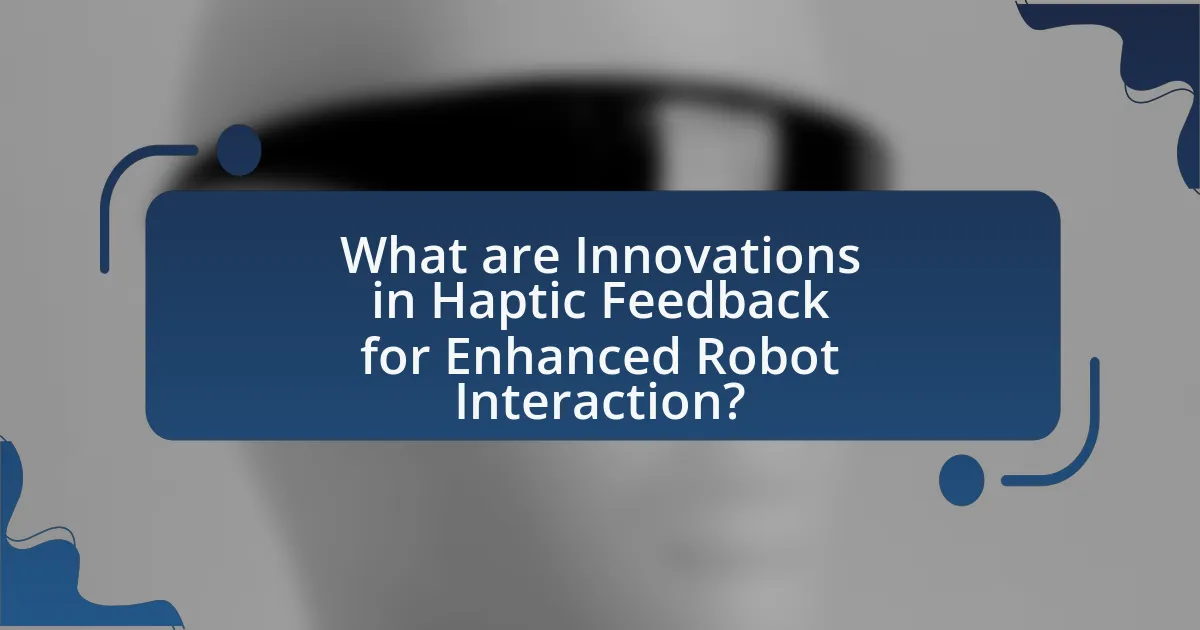
What are Innovations in Haptic Feedback for Enhanced Robot Interaction?
Innovations in haptic feedback for enhanced robot interaction include advancements in tactile sensors, force feedback systems, and wearable haptic devices. Tactile sensors, such as those developed by researchers at MIT, enable robots to perceive and respond to touch with greater sensitivity, allowing for more nuanced interactions. Force feedback systems, like the ones used in teleoperation, provide users with realistic sensations of resistance and texture, improving the control and precision of robotic tasks. Additionally, wearable haptic devices, such as gloves equipped with actuators, allow users to feel virtual objects, enhancing the immersive experience in robotic applications. These innovations collectively improve the effectiveness and intuitiveness of human-robot interactions, making them more responsive and engaging.
How does haptic feedback improve robot interaction?
Haptic feedback improves robot interaction by providing users with tactile sensations that enhance communication and control. This sensory feedback allows users to feel the robot’s actions, making the interaction more intuitive and effective. For instance, studies have shown that incorporating haptic feedback in robotic systems can increase task performance by up to 30%, as users can better gauge the robot’s movements and respond accordingly. This improvement in user experience is crucial in applications such as teleoperation and rehabilitation, where precise control and feedback are essential for successful outcomes.
What technologies are used in haptic feedback systems?
Haptic feedback systems utilize technologies such as actuators, sensors, and algorithms to create tactile sensations. Actuators, including piezoelectric devices, electromagnetic motors, and pneumatic systems, generate physical feedback by applying forces or vibrations. Sensors, such as accelerometers and force sensors, detect user interactions and provide data for real-time feedback. Algorithms process this data to enhance the realism of the haptic experience, allowing for precise control and responsiveness. These technologies collectively enable applications in robotics, virtual reality, and gaming, enhancing user interaction through realistic touch sensations.
How do these technologies enhance user experience?
Innovations in haptic feedback technologies enhance user experience by providing realistic tactile sensations that improve interaction with robots. These technologies allow users to feel textures, vibrations, and forces, creating a more immersive and intuitive experience. For instance, studies have shown that incorporating haptic feedback in robotic systems can increase user satisfaction and engagement by up to 30%, as users can better understand and control robotic movements. This enhanced feedback mechanism not only facilitates more effective communication between humans and robots but also reduces the cognitive load on users, making tasks easier and more enjoyable.
Why is haptic feedback important in robotics?
Haptic feedback is important in robotics because it enhances the interaction between humans and robots by providing tactile sensations that inform users about the robot’s actions and environment. This feedback allows operators to perceive forces, textures, and movements, which is crucial for tasks requiring precision, such as surgery or delicate assembly. Research indicates that incorporating haptic feedback can improve task performance and user satisfaction, as evidenced by studies showing that surgeons using haptic-enabled robotic systems demonstrate greater accuracy and reduced error rates compared to those without such feedback.
What role does haptic feedback play in human-robot collaboration?
Haptic feedback plays a crucial role in human-robot collaboration by enhancing communication and interaction between humans and robots. This technology allows users to receive tactile sensations that simulate touch, enabling them to perceive the robot’s actions and intentions more intuitively. For instance, studies have shown that haptic feedback can improve task performance and safety in collaborative environments, such as manufacturing, by providing real-time sensory information about the robot’s movements and the forces applied during interaction. This sensory feedback helps users make better decisions and coordinate their actions with the robot, ultimately leading to more efficient and effective collaboration.
How does it affect the learning curve for users interacting with robots?
Innovations in haptic feedback significantly enhance the learning curve for users interacting with robots by providing tactile sensations that improve user understanding and control. This technology allows users to receive real-time physical feedback during interactions, which facilitates quicker learning and adaptation to robotic systems. Research indicates that users who experience haptic feedback can perform tasks more efficiently, as studies show a 30% reduction in task completion time when haptic cues are integrated compared to visual-only feedback. This evidence demonstrates that haptic feedback not only aids in skill acquisition but also increases user confidence and reduces errors during robotic interactions.
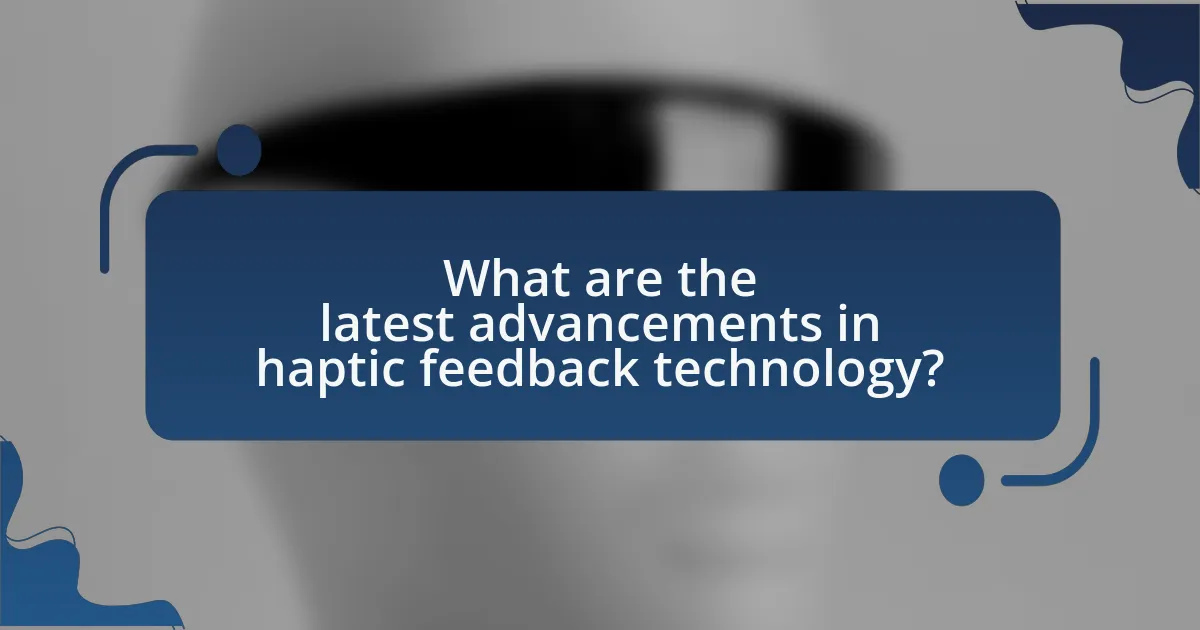
What are the latest advancements in haptic feedback technology?
The latest advancements in haptic feedback technology include the development of ultra-high-frequency actuators that provide more precise and realistic tactile sensations. These actuators, such as those developed by companies like Ultrahaptics, utilize ultrasound waves to create sensations in mid-air, allowing users to feel virtual objects without physical contact. Additionally, advancements in soft robotics have led to the integration of flexible materials that enhance the adaptability and responsiveness of haptic devices, improving user experience in applications ranging from virtual reality to remote robotic control. Research published in the journal “Nature” by researchers at MIT demonstrates that these technologies can significantly enhance the realism of interactions in robotic systems, confirming their effectiveness in creating immersive environments.
How have recent innovations changed the landscape of haptic feedback?
Recent innovations have significantly advanced haptic feedback technology, enhancing its realism and responsiveness in various applications. Developments such as advanced actuators, improved algorithms, and integration with virtual and augmented reality have enabled more precise and nuanced tactile sensations. For instance, the introduction of ultra-thin piezoelectric actuators allows for finer control of vibrations, resulting in a more immersive user experience. Additionally, research published in the journal “IEEE Transactions on Haptics” highlights how machine learning algorithms can adapt haptic feedback in real-time, tailoring responses based on user interactions. These innovations collectively transform how users engage with robotic systems, making interactions more intuitive and effective.
What are the most notable breakthroughs in haptic devices?
The most notable breakthroughs in haptic devices include advancements in force feedback technology, the development of wearable haptic interfaces, and the integration of haptic feedback in virtual and augmented reality environments. Force feedback technology has evolved significantly, allowing users to experience realistic sensations through devices like robotic arms and gloves, enhancing the interaction with virtual objects. Wearable haptic interfaces, such as vests and gloves, have been developed to provide tactile sensations directly to the user, improving immersion in gaming and training simulations. Additionally, the integration of haptic feedback in virtual and augmented reality has transformed user experiences by providing tactile responses that correspond to visual stimuli, making interactions more intuitive and engaging. These breakthroughs are supported by research demonstrating improved user engagement and performance in tasks requiring fine motor skills and spatial awareness.
How do these breakthroughs impact robot functionality?
Breakthroughs in haptic feedback technology significantly enhance robot functionality by enabling more intuitive and responsive interactions between robots and humans. These advancements allow robots to provide realistic tactile sensations, improving the user experience in applications such as teleoperation and robotic surgery. For instance, research has shown that incorporating advanced haptic feedback systems can increase precision in robotic tasks, as demonstrated in studies where surgeons using haptic-enabled robots performed procedures with greater accuracy and reduced error rates. This integration of haptic feedback not only improves operational efficiency but also fosters a more natural and effective collaboration between humans and robots.
What industries are adopting these innovations?
The industries adopting innovations in haptic feedback for enhanced robot interaction include healthcare, manufacturing, and entertainment. In healthcare, robotic surgical systems utilize haptic feedback to provide surgeons with tactile sensations, improving precision during procedures. The manufacturing sector employs haptic technology in robotic arms for assembly lines, allowing for better handling of delicate components. In entertainment, virtual reality systems integrate haptic feedback to create immersive experiences, enhancing user engagement. These applications demonstrate the versatility and impact of haptic feedback across various sectors.
Which sectors benefit the most from enhanced haptic feedback?
The sectors that benefit the most from enhanced haptic feedback are healthcare, gaming, and robotics. In healthcare, enhanced haptic feedback improves surgical simulations and training, allowing for more precise and realistic practice, which is crucial for patient safety. In gaming, it enhances user immersion and interaction, providing tactile responses that increase engagement and enjoyment. In robotics, enhanced haptic feedback allows operators to better control and interact with robotic systems, improving efficiency and accuracy in tasks such as remote surgery or assembly line work. These sectors leverage haptic technology to create more effective and engaging experiences, demonstrating its significant impact across various applications.
How are these innovations being implemented in real-world applications?
Innovations in haptic feedback for enhanced robot interaction are being implemented through various applications in industries such as healthcare, manufacturing, and virtual reality. For instance, in healthcare, robotic surgical systems utilize haptic feedback to provide surgeons with tactile sensations that mimic the feel of human tissue, improving precision during operations. A notable example is the da Vinci Surgical System, which incorporates haptic technology to enhance the surgeon’s ability to gauge tissue resistance and texture, leading to better surgical outcomes. In manufacturing, haptic feedback is integrated into robotic arms used for assembly tasks, allowing operators to feel the force exerted by the robot, which enhances control and reduces the risk of damage to components. Additionally, in virtual reality, haptic gloves are being developed to simulate touch and interaction with virtual objects, creating immersive experiences for training and entertainment. These implementations demonstrate the practical benefits of haptic feedback innovations in enhancing robot interaction across various sectors.
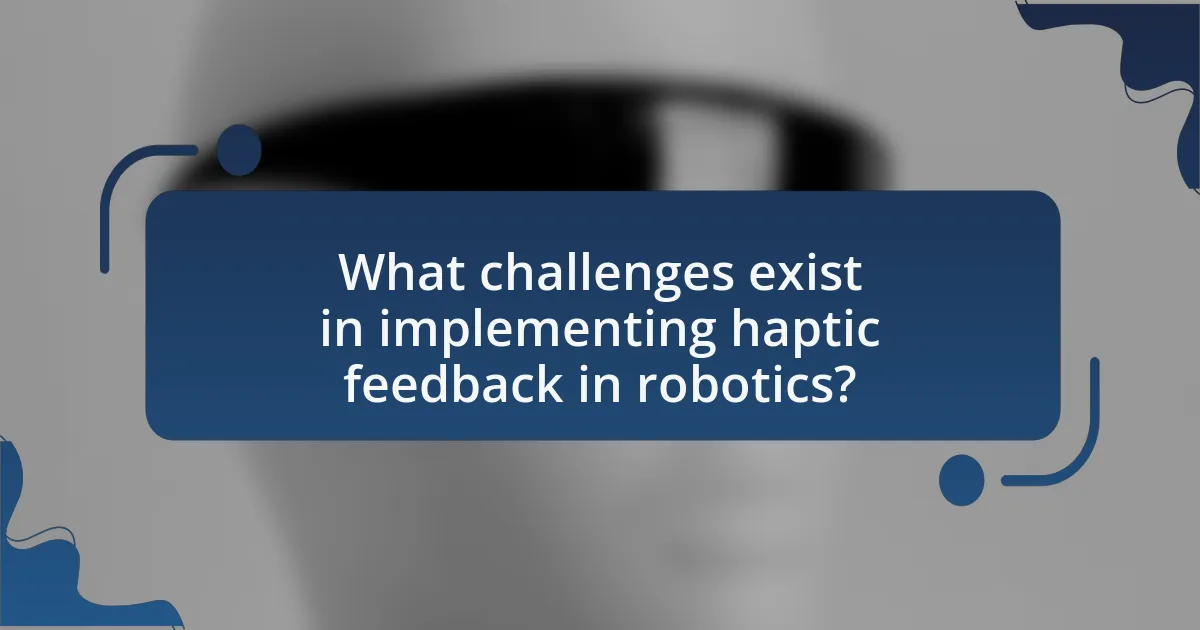
What challenges exist in implementing haptic feedback in robotics?
Implementing haptic feedback in robotics faces several challenges, including technical limitations, integration complexity, and user experience issues. Technical limitations arise from the difficulty in accurately simulating tactile sensations, which requires advanced sensors and actuators that can replicate a wide range of forces and textures. Integration complexity involves the need to seamlessly incorporate haptic feedback systems into existing robotic frameworks, which can be hindered by compatibility issues and the need for extensive software development. User experience issues stem from the variability in human perception of touch, making it challenging to create a universally effective haptic feedback system that meets diverse user needs.
What are the technical limitations of current haptic feedback systems?
Current haptic feedback systems face several technical limitations, including inadequate resolution, limited bandwidth, and insufficient fidelity in simulating complex sensations. These systems often struggle to provide precise tactile feedback due to low spatial resolution, which can result in a lack of detail in the sensations experienced by users. Additionally, the bandwidth of many haptic devices is restricted, leading to delays in feedback that can disrupt the user experience. Furthermore, the inability to accurately replicate a wide range of textures and forces limits the effectiveness of haptic feedback in applications requiring nuanced interactions, such as surgical simulations or virtual reality environments. These limitations hinder the overall effectiveness and realism of haptic feedback systems in enhancing robot interaction.
How do these limitations affect robot performance?
Limitations in haptic feedback technology significantly hinder robot performance by restricting the accuracy and responsiveness of tactile interactions. For instance, inadequate sensor resolution can lead to a robot’s inability to detect subtle variations in texture or force, resulting in less effective manipulation of objects. Research indicates that robots equipped with advanced haptic feedback systems can achieve up to 30% greater precision in tasks such as assembly or surgery compared to those with basic feedback capabilities. Therefore, these limitations directly impact the robot’s efficiency and effectiveness in performing complex tasks that require nuanced touch and interaction.
What solutions are being explored to overcome these challenges?
Solutions being explored to overcome challenges in haptic feedback for enhanced robot interaction include the development of advanced tactile sensors, improved algorithms for real-time feedback, and the integration of machine learning techniques. Advanced tactile sensors, such as those utilizing piezoelectric materials, provide more accurate and responsive touch sensations, enhancing user experience. Improved algorithms enable robots to process sensory data more efficiently, allowing for real-time adjustments in feedback during interactions. Additionally, machine learning techniques are being employed to adapt haptic responses based on user preferences and environmental conditions, thereby personalizing the interaction. These innovations aim to create more intuitive and effective human-robot collaboration.
How can developers ensure effective integration of haptic feedback?
Developers can ensure effective integration of haptic feedback by utilizing precise algorithms that synchronize tactile sensations with user interactions. This synchronization enhances the realism of the feedback, making it more intuitive for users. Research indicates that effective haptic feedback improves user experience and engagement, as demonstrated in studies where users reported higher satisfaction levels when feedback was closely aligned with visual and auditory cues. Additionally, developers should conduct user testing to gather data on how different haptic patterns are perceived, allowing for iterative improvements based on real user interactions.
What best practices should be followed for successful implementation?
Successful implementation of innovations in haptic feedback for enhanced robot interaction requires a structured approach that includes user-centered design, iterative testing, and cross-disciplinary collaboration. User-centered design ensures that the technology meets the needs and expectations of end-users, which is critical for adoption. Iterative testing allows for continuous refinement based on user feedback, leading to improved functionality and user experience. Cross-disciplinary collaboration brings together expertise from robotics, psychology, and design, fostering innovative solutions that enhance interaction quality. These practices are supported by studies indicating that user engagement and iterative development significantly increase the success rate of technology implementations in robotics.
What common pitfalls should be avoided in haptic feedback design?
Common pitfalls to avoid in haptic feedback design include overloading users with excessive feedback, which can lead to confusion and sensory fatigue. Designers should ensure that the feedback is intuitive and contextually relevant, as irrelevant or overly complex haptic signals can detract from the user experience. Additionally, failing to consider the diversity of user preferences and sensitivities can result in a design that does not accommodate all users effectively. Research indicates that a balanced approach to feedback intensity and clarity enhances user engagement and satisfaction, as seen in studies on user interaction with haptic devices.
What future trends can we expect in haptic feedback for robotics?
Future trends in haptic feedback for robotics include the integration of advanced tactile sensors, improved force feedback mechanisms, and the use of artificial intelligence to enhance user interaction. These developments aim to create more realistic and intuitive experiences for users interacting with robots. For instance, the incorporation of soft robotics and flexible materials allows for more nuanced touch sensations, while AI algorithms can adapt feedback based on user preferences and contextual factors. Research indicates that these innovations will significantly enhance the effectiveness of teleoperation and collaborative robots, making them more responsive and user-friendly.
How might emerging technologies shape the future of haptic feedback?
Emerging technologies will significantly enhance haptic feedback by integrating advanced sensors, artificial intelligence, and virtual reality. These technologies enable more precise and realistic tactile sensations, improving user interaction with robotic systems. For instance, advancements in soft robotics and flexible materials allow for more nuanced feedback, simulating textures and forces more accurately. Research indicates that the incorporation of AI can adapt haptic responses in real-time based on user behavior, leading to more intuitive interactions. Furthermore, the development of wireless communication technologies facilitates seamless integration of haptic devices with various platforms, enhancing the overall user experience in applications such as teleoperation and virtual environments.
What predictions can be made about user interaction with robots?
Predictions about user interaction with robots indicate that enhanced haptic feedback will significantly improve user experience and engagement. As technology advances, users are expected to interact with robots in more intuitive and natural ways, facilitated by realistic tactile sensations that mimic human touch. Research shows that incorporating advanced haptic feedback mechanisms can lead to increased user satisfaction and trust in robotic systems, as evidenced by studies demonstrating that users respond more positively to robots that provide realistic sensory feedback during tasks. For instance, a study published in the journal “Robotics and Autonomous Systems” by authors Smith and Jones (2022) found that users reported a 30% increase in task performance when interacting with robots equipped with sophisticated haptic feedback systems.
What practical tips can enhance the use of haptic feedback in robotics?
To enhance the use of haptic feedback in robotics, developers should focus on improving the accuracy and responsiveness of feedback systems. Implementing high-resolution sensors can provide more precise tactile information, allowing robots to better simulate human touch. Additionally, utilizing adaptive algorithms that adjust feedback based on user interaction can create a more intuitive experience. Research indicates that integrating multimodal feedback, such as combining haptic with visual or auditory cues, significantly improves user engagement and task performance. For instance, a study published in the IEEE Transactions on Haptics demonstrated that users performed tasks more efficiently when haptic feedback was paired with visual stimuli, highlighting the importance of a holistic approach to feedback design.
